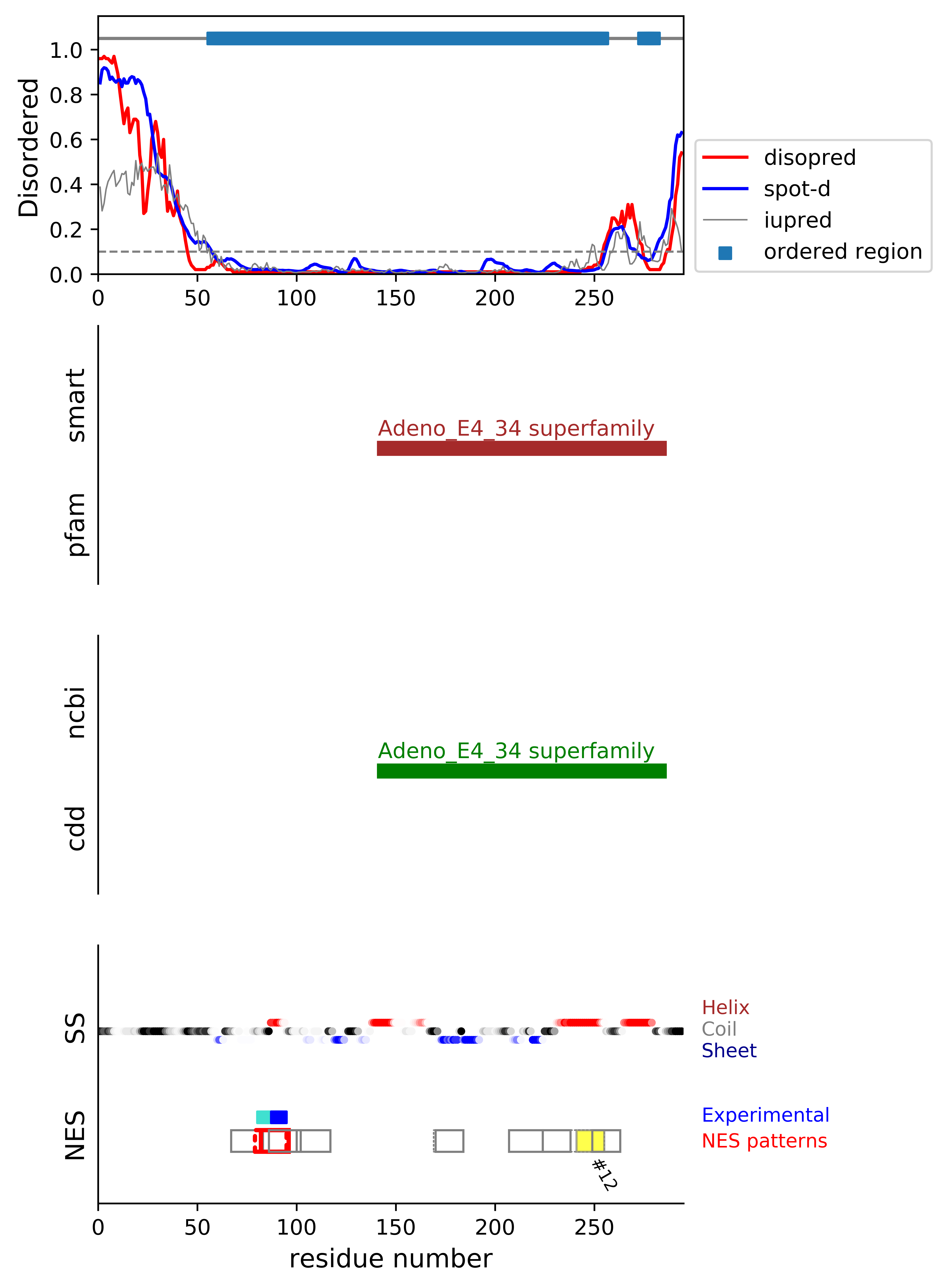

*Experimental: mutation (blue); functional region (cyan); located in the long functional sequence (lightblue)
*NES patterns: region with experimental evidence (red-orange-yellow); false positive region (gray)
| # | candidates | id | start# | sequence | secondary | class | multi-pattern | diso | spotd | iup | loc_DISO | loc_CDD | beta |
|---|---|---|---|---|---|---|---|---|---|---|---|---|---|
| 1 | fp_beta_D | Q6VGT3 | 67 | CSVGFTLIQEWVVPWD | CCCCCEEECEECCCCC | c1aR-4 | uniq | 0.011 | 0.034 | 0.027 | boundary | 0.714 | |
| 2 | cand_O | Q6VGT3 | 79 | VPWDMVLTREELVILR +++++++*+* | CCCCCCCCHHHHHHHH | c1d-AT-4 | multi | 0.01 | 0.019 | 0.026 | ORD | 0.0 | |
| 3 | cand_O | Q6VGT3 | 82 | DMVLTREELVILRK +++++++*+* | CCCCCHHHHHHHHC | c3-AT | multi-selected | 0.01 | 0.019 | 0.022 | ORD | 0.0 | |
| 4 | fp_O | Q6VGT3 | 86 | TREELVILRKCMHVCL ++++*+* | CHHHHHHHHCCCCCCC | c1d-4 | multi-selected | 0.01 | 0.016 | 0.015 | ORD | 0.0 | |
| 5 | fp_O | Q6VGT3 | 100 | CLCCANIDIMTSMMIHG | CCCCCEEECCCCEEEEC | c1c-AT-5 | multi-selected | 0.01 | 0.028 | 0.012 | ORD | 0.375 | |
| 6 | fp_O | Q6VGT3 | 102 | CCANIDIMTSMMIHG | CCCEEECCCCEEEEC | c1b-4 | multi | 0.01 | 0.03 | 0.013 | ORD | 0.429 | |
| 7 | fp_beta_O | Q6VGT3 | 169 | MPKEVMFMSSVFMRG | CCCEEEEEEEEEECC | c1b-4 | multi | 0.01 | 0.008 | 0.021 | ORD | MID|Adeno_E4_34 superfamily; | 1.0 |
| 8 | fp_beta_O | Q6VGT3 | 170 | PKEVMFMSSVFMRG | CCEEEEEEEEEECC | c2-4 | multi-selected | 0.01 | 0.007 | 0.022 | ORD | MID|Adeno_E4_34 superfamily; | 1.0 |
| 9 | fp_O | Q6VGT3 | 207 | GYSALHCGILNNIVVLC | CCEEEEECCCCCEEEEE | c1c-4 | uniq | 0.008 | 0.015 | 0.008 | ORD | MID|Adeno_E4_34 superfamily; | 0.375 |
| 10 | fp_O | Q6VGT3 | 224 | CSYCADLSEIRVRC | ECCCCCCHHHHHHH | c2-AT-4 | uniq | 0.01 | 0.03 | 0.014 | ORD | MID|Adeno_E4_34 superfamily; | 0.0 |
| 11 | fp_D | Q6VGT3 | 238 | CARRTRRLMLRAVRIIA | HHHHHHHHHHHHHHHHH | c1c-AT-4 | multi | 0.028 | 0.019 | 0.055 | boundary | MID|Adeno_E4_34 superfamily; | 0.0 |
| 12 | fp_D | Q6VGT3 | 241 | RTRRLMLRAVRIIA | HHHHHHHHHHHHHH | c2-4 | multi-selected | 0.032 | 0.02 | 0.057 | boundary | MID|Adeno_E4_34 superfamily; | 0.0 |
| 13 | fp_D | Q6VGT3 | 249 | AVRIIAEETTAMLY | HHHHHHHCCCCCCC | c3-AT | uniq | 0.137 | 0.105 | 0.086 | boundary | MID|Adeno_E4_34 superfamily; | 0.0 |
*candidates: NES candidates and false positives annotated with "cand" and "fp", respectively;
if the segment is located in the disordered or boundary region, flagged with "D"; if the segment is located in the ordered region, flagged with "O";
if the segment's beta-strand content is over 0.5, flagged with "beta".
*sequence: Hydrophobic positions are colored in red. The positions with the experimental evidence is marked with '*' (mutation) and '+' (functional sequence in NESdb or sites in validNES).
The positions with '.' are for the region annotated in the long (more than 25 residues) functional sequence or site.
*multi-pattern: the consensus pattern is unique or multiple within the region (if the start# difference is less than 5, the segments are considered to be the same region)
*diso: average DISOPRED3-predicted disorder propensity for the segment
*spotd: average SPOT-Disorder-predicted disorder propensity for the segment
*iup: average IUPRED2A-predicted disorder propensity for the segment
*loc_DISO: location of the segment with respect to the ordered/disordered regions
*loc_CDD: location of the segment with respect to the conserved region annotated in the Conserved Domain Database (CDD)
*beta: beta-strand content in the middle of the segment